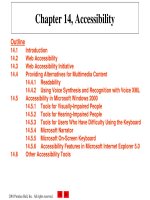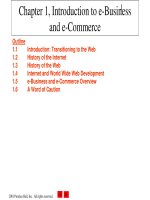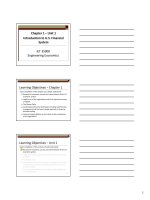Lecture Communication research: Asking questions, finding answers (4e) Chapter 14: Introduction to qualitative research
Bạn đang xem bản rút gọn của tài liệu. Xem và tải ngay bản đầy đủ của tài liệu tại đây (289.84 KB, 13 trang )
Chapter 14
INTRODUCTION TO
QUALITATIVE RESEARCH
Copyright © 2015 McGraw-Hill
Education. All rights reserved. No
reproduction or distribution without
the prior written consent of
McGraw-Hill Education.
WHAT IS QUALITATIVE RESEARCH
Preserves the form and content of interaction
Contextually situated
Discourse is the data
Analyzed for its qualities – empirical, inductive, and
interpretive
Aims for subjectivity
Allows interactants’ voices to be heard
Copyright © 2015 McGraw-Hill
Education. All rights reserved. No
reproduction or distribution without
the prior written consent of
McGraw-Hill Education.
WHAT IS QUALITATIVE RESEARCH?
Intersubjectivity
The
social accomplishment of how people coconstruct and co-experience their social life and
rules for doing so
How do people understand and interpret
communication processes?
How is communication socially situated?
Copyright © 2015 McGraw-Hill
Education. All rights reserved. No
reproduction or distribution without
the prior written consent of
McGraw-Hill Education.
MUTUAL SIMULTANEOUS SHAPING
The here and now
Everything influences
everything else
Emphasis on process
and the holistic frame of
interaction
Plausible explanations
built on what is
observed
Copyright © 2015 McGraw-Hill
Education. All rights reserved. No
reproduction or distribution without
the prior written consent of
McGraw-Hill Education.
INDUCTIVE ANALYSIS
From the specific to the general
Explanations and theories emerge from the
data
Propositions formulated continuously
throughout the data collection and data
analysis process
Copyright © 2015 McGraw-Hill
Education. All rights reserved. No
reproduction or distribution without
the prior written consent of
McGraw-Hill Education.
MODEL FOR QUALITATIVE RESEARCH
•
•
•
•
•
Interdependent stages
Not linear
Cannot be planned in
entirety
Top circle reflects
design of the project
Bottom reflects
activities in the field
Copyright © 2015 McGraw-Hill
Education. All rights reserved. No
reproduction or distribution without
the prior written consent of
McGraw-Hill Education.
CREDIBILITY IN QUALITATIVE RESEARCH
Extent to which data interpretations are
true
correct
dependable
Allows for multiple interpretations by asking
“What’s plausible?”
Copyright © 2015 McGraw-Hill
Education. All rights reserved. No
reproduction or distribution without
the prior written consent of
McGraw-Hill Education.
ENHANCING CREDIBILITY
Triangulation: use of several kinds of methods or data
to enhance credibility
Data triangulation
Investigator triangulation
Interdisciplinary triangulation
Member validation
Taking research findings back to individuals who provided
data
Copyright © 2015 McGraw-Hill
Education. All rights reserved. No
reproduction or distribution without
the prior written consent of
McGraw-Hill Education.
CONCEPTUALIZING RESEARCH QUESTIONS
FOR QUALITATIVE RESEARCH
Based on previous literature
Broadly stated
Nondirectional
Gives researcher latitude in following interesting paths
Specific to the interaction context
Copyright © 2015 McGraw-Hill
Education. All rights reserved. No
reproduction or distribution without
the prior written consent of
McGraw-Hill Education.
ASSESSING QUALITATIVE RESEARCH QUESTIONS
Should ask how or
what?
Should reference the
research site?
Does the
research
question --
Focus on a specific type of
interaction?
Discover how meaning is
developed/shared?
Reveal naturally occurring
communication not suitable for
study in an experiment?
Reveal unanticipated
phenomena/influences?
Reveal process that occur over
time?
Explore the influences of the
context?
Copyright © 2015 McGraw-Hill
Education. All rights reserved. No
reproduction or distribution without
the prior written consent of
McGraw-Hill Education.
WHAT COUNTS AS QUALITATIVE DATA?
Anything that can be observed or captured
Interpreting meaning
Researcher construction
Subjective valuing
Contingent accuracy
Level of evidence
Microlevel, midlevel, macrolevel
Copyright © 2015 McGraw-Hill
Education. All rights reserved. No
reproduction or distribution without
the prior written consent of
McGraw-Hill Education.
ADVANTAGES
Documents the unseen
Provides information
about those who cannot
or will not speak for
themselves
Supplements
information from
quantitative studies
LIMITATIONS
Communication
environment must be
accessible
Interactants may change
their behavior
Observations filtered
through the researcher
Time consuming
WHY CHOOSE QUALITATIVE RESEARCH?
THREATS TO CREDIBILITY
Inaccuracy or incompleteness of data
Problems of interpretation
Whose interpretation is being imposed?
Theoretical validity
What about data that fail to fit the interpretation?
Selection bias
Reactivity bias
Copyright © 2015 McGraw-Hill
Education. All rights reserved. No
reproduction or distribution without
the prior written consent of
McGraw-Hill Education.









